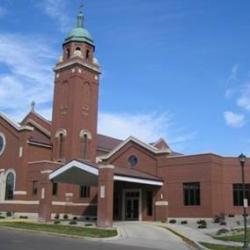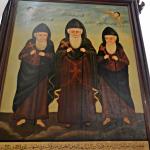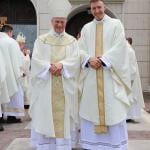
In Chile, Cavanaugh says, “It should come as no surprise that reception of the Eucharist increased dramatically among the poor during the military dictatorship.” (p. 268) The regime had claimed the whole of public space for itself. For a time the Church thought it could operate freely in what was left—the private space of individual hearts and souls. But celebrating Eucharist, i.e. “going to church,” is a public act and, for many, the only public act available.
Concluding the series on Torture and Eucharist: Theology, Politics, and the Body of Christ, ninth in the series on William T. Cavanaugh. He is a Catholic theologian who writes about the Church and its role in culture, politics, and economics. Introduction to Cavanaugh and links to blogs in the series as they appear are here.
Catholics in the United States need to start thinking about going to Church as a public act against forces in society pushing religion to the sidelines. I intend to support this claim by reference to William Cavanaugh’s concept of an imagination. The conflict in Chile was between two imaginations, the state’s and (after a while) the Church’s. It’s the same here except for a reversal in one of the imaginations. In Chile the state used an economic system in support of its imagination. In the U.S. the imagination belongs to the economy, and it manipulates the state for its purposes.
The imagination of state and Eucharist in Chile
Cavanaugh refers to torture as “the imagination of the state.” (p. 279 and other places) Torture prods the imagination in a certain direction, toward individual isolated persons related only to an overarching and all-powerful state. When people experience Eucharist, a new imagination asserts itself. To perform Eucharist is to be caught up, body as well as soul, in the body of Christ and to resist the state’s determination to define what is real.
In giving their bodies to Christ in the Eucharist, confession is made, but it is not the voice of the state that is heard. The torturer extracts a confession of the unlimited power of the state. The Eucharist requires the confession that Jesus is Lord of all, and that the body belongs to Him. (279)
The torturer relies on the fact that each one’s pain is his or her own to produce a mass of individuals related only to the state. Christians claim
that pain can be shared, precisely because people can be knitted together into one body. The Sebastián Acevedo Movement relies on the “mysterious channels” of this body, its joints and ligaments, to assume the pain of the tortured. On a larger scale, the Vicaría frustrates the torture of the body politic by forming communities where sufferings and deprivations can be shared and overcome. (p. 280) (See previous post for the Sebastián Acevedo Movement and the Vicaría de Solidaridad.)
Imaginations of space and time
Torture pares each person’s space down to the confines of an individual body. Torture and fear narrow time also to a fleeting moment. Past relationships and future hopes disappear into an anxious present.
Eucharist challenges both parts, spatial and temporal, of the state’s narrowing of imagination. The “one body” that approaches Eucharist consists of many members sharing the space of a solemn procession. They have already together praised God, shared Christ’s peace, and confessed each one’s need for forgiveness. Eucharist also includes sharing in a story that brings both past and future to bear on the present.
In the Eucharist the church keeps alive the subversive memory of Christ’s past confrontation with, and triumph over, worldly power. At the same time, the Eucharist anticipates the future realization of a new society, the Kingdom of God, which will shatter the obdurate monuments of the mighty. (p. 280)
Imagining martyrs
Torture needs invisibility, a secret police, and, especially, the disappearance of bodies. There would be victims only, not martyrs (i.e., witnesses). There’s a strange and ancient practice of Catholics that is still current, though fading from people’s awareness. We celebrate Mass over a relic of a saint buried in the altar. Often it’s a martyr but in any case one who has both lived and died as a witness to Jesus. It is a faint echo of the early days when Christians celebrated Eucharist on the tomb of a martyr.
In Chile, especially for the poor, Eucharist brought the concept of martyrdom to life.
The Eucharist … creates martyrs out of victims by calling the Church to acts of self-sacrifice and remembrance [as in the Acevedo Movement and the Vicariate of Solidarity]…. (p. 281)
Something I learned about Eucharist long ago: The signs of the Eucharist, and indeed of any sacrament, are actions, not things. We speak of the elements of the Eucharist as bread and cup, but the sign of the Eucharist is actually the breaking and sharing of the one bread, the sharing in the one cup. An early name for Eucharist speaks of action – the “Breaking of the Bread.” The word “liturgy” says the same thing: It is the work of the people.
Extrapolating to what I did not imagine then, the Church, a sacrament in its own right, is an action, not a thing. Cavanaugh says the Church is a performance.
Re-imagining Eucharist
I once thought Sunday Mass was a time of grace. Other days of the week I’d put that grace to work. The deacon echoes that thought at the end of Mass when he says something like, “Go and witness to the Gospel with your lives.”. Not a bad idea, but it may be a good idea that obscures a better one. Participating in Liturgy is already a living of and witness to the Gospel. In fact, it’s the people’s most important work.
Economies and states want to restrict religion to the private sphere, to the individual and God, so as to have free reign over our public lives. As long as they have to live with religion, they want religion on a separate plane. That was true in Pinochet’s Chile, first of the tyrannical political system and second of its handmaid, neo-liberal, laissez-faire, “Chicago Boys” economics.
In countries that don’t generally practice torture on their own citizens, it may be somewhat different. In the United States it’s the economy that wants to hold imperial sway over society, and it engenders its preferred politics. It tries to control people’s imaginations. How many times have you heard that you are a consumer? When not a consumer, then you’re a producer. Our economy is fine with churches as long as they are just time off, time to recover and jump back into producing and consuming.
Going to church, being together with a worshiping community, doesn’t need to be just a time off in some other world. God doesn’t give us such a place. Time off is good, but the Eucharist is a public witness against the hectic or humdrum pace this economic regime requires. It refuses to keep religion private. It defies the distinction of religious and public planes.
Justice and charity
To make that Eucharistic defiance effective, the Church needs to stop talking from a “high ground” above politics. We need to claim a counter politics. Our neo-liberal economy operates under a set of rules that sanctifies competition. Of course, if you’re powerful enough you can bend or break the rules you don’t like. Regardless, the system inevitably creates poor people. It assigns the task of caring for the poor to “charity.” Eucharist says action on behalf of the poor is not charity but justice.
A soup kitchen, for example, is not a handout but a political witness against a system that is failing people. And a soup kitchen is not normal. Normally, people should feed themselves and their families. It’s an abnormal situation when they can’t. Charity is for an abnormal situation like a like flood or drought or depression. Things should return to normal as soon as possible.
We live in an economy that makes the abnormal normal. Four percent unemployment is “full employment.” It’s not only the best we can get; it’s the goal this economy aims for. It wants a permanent supply of bodies to fill in when the economy needs more workers.
The imagination of a capitalist economy tells us to be happy when unemployment gets down to four percent. It tells us to be satisfied with ourselves that we have designed government and private programs for the poor. It calls the programs hand-outs to indicate that we are going beyond the call of duty. The recipients of our charity should be grateful. Generosity is a burden, so we find reasons to limit our generosity. We tell imaginative stories about Cadillacs driving to the food shelf and immigrants coming in so they can get on welfare.
Eucharistic counter-economics
Consumer society tells us to imagine a world of goods out there to be consumed. We take these things to ourselves; they become part of our ever-expanding selves. Other than that, they have no meaning.
There is consuming also in the Eucharist but it operates according to a different imagination. What we consume doesn’t become part of us. We become part of it. The Eucharist imagines a body to which all belong. It’s not a “mystical” body but the true Body of Christ, a real, solid body to challenge this world.
Image “Imagination” by Benjamin. Credit: Reddit via Google Images












